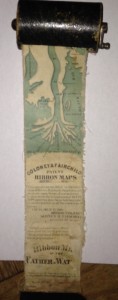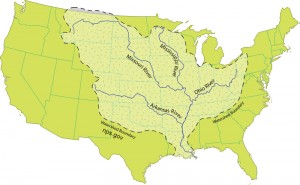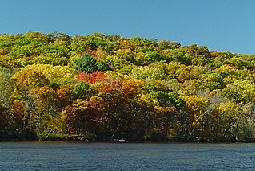Feature story by Pat Middleton may not be used without written permission from Great River Publishing
Birders craving an excuse to “head on down to the river” during the months of December through March, take note! The major concentrations of American bald eagles in the entire continental U.S. now winter near the open waters at the Locks and Dams of the Mississippi River.From Red Wing, Minnesota, to Reelfoot Lake, Tennessee, organized public eagle watches are celebrating one of our nation’s brightest environmental come-backs. |
The American Bald Eagle is nothing if not resilient. In the 1960’s Rachel Carson drew attention to their devastating decline with her report that on the entire Mississippi River her counters found only 59 eagles. The effects of DDT, habitat destruction, and human persecution had taken a toll on a population, which once counted many thousands on the Upper River. The few remaining birds tended to winter near Union Dam in Keokuk, Iowa, where fish stunned by the turbulence and aeration of the water offered eagles easy foraging. Opposite Keokuk, along the Illinois shore, large trees, sheltered by the Iowa bluffs provided excellent perching and roosting sites.
Although DDT was banned in 1972, it wasn’t until 1985 that people started to notice a true increase in the eagle population. Pat Schlarbaum, at the time a Fish & Wildlife Specialist with the Iowa DNR, thought it was time to celebrate.
“The Keokuk Eagle Watch Days were really instigated as a celebration of the success of our wintering population of eagles,” Pat says. “We had no idea the notion would catch on along the entire river. The Keokuk Watch now features nearly 500 wintering eagles, volunteer spotters, donated binoculars and spotting scopes. It’s exciting enough to draw viewers from around the nation. In addition, the public lectures and presentations by DNR personnel, volunteers from Raptor Rehab Centers, and the Army Corps of Engineers have provided our agencies with an outstanding opportunity to educate the general public about raptors, our birds of prey. Volunteers bring not only live eagles, but owls, hawks, and even peregrine falcons to the presentations.” (continued below, Click CONTINUE READING)

 ort from Clements Fishing Barge: “November 3rd: Fishing has been pretty good for walleye and sauger. White bass are done and the perch scarce. Most fish are coming in on minnows or hair jigs. Guys are still using 1 oz jigs, water is still higher than normal, but fish are in.”
ort from Clements Fishing Barge: “November 3rd: Fishing has been pretty good for walleye and sauger. White bass are done and the perch scarce. Most fish are coming in on minnows or hair jigs. Guys are still using 1 oz jigs, water is still higher than normal, but fish are in.” Welcome! IT’S A GREAT RIVER! and a GREAT GIFT… for your favorite Mississippi or Missouri River Buff, Retiree, or Armchair Traveler!
Welcome! IT’S A GREAT RIVER! and a GREAT GIFT… for your favorite Mississippi or Missouri River Buff, Retiree, or Armchair Traveler!






